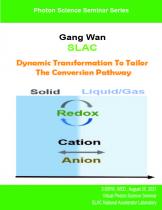Speaker: Gang Wan, SLAC
Program Description:
Efficient energy conversion and chemical transformation are required for a carbon-neutral society. At the core of this transition lies the electrochemical and thermochemical pathways. As these technologies have matured, it has become apparent that the chemical and structural transformations that are both time and reaction-dependent are also critical materials processes. This calls for new insights into these dynamic transformation processes and their roles on device degradation and surface activation. In this talk, the structure and redox evolution of model thin-films and supported particles in complex reaction environments is revealed by surface-sensitive X-ray studies, mass and vibrational spectroscopic probes in conjunction with thermodynamic analysis. Structural and chemical transformation of thin films in electrolyte and after charging elucidates the underlying interfacial protonation reaction. This in turn directs the interphase formation and redox modification in layered cathode, accounting for device degradation. In addition to the interfacial degradation, the opportunity on the manipulation of materials transformation also reveals a dynamic nature. In the catalytic conversion of methane and carbon monoxide, a reversible transformation of catalyst states responding to the reaction environments is achieved, therefore overcoming the activity limitation and sintering issues in the emission control. It is believed that progress in the fundamental understanding of dynamic materials behaviors, encompassing both the material defects and working environment, can revolutionize the development of alternative conversion systems as a viable replacement to traditional technologies.





